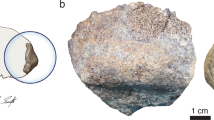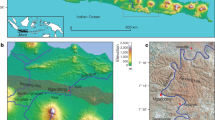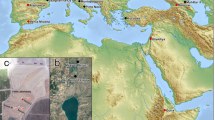Abstract
The genesis, evolution and fate of Homo erectus have been explored palaeontologically since the taxon's recognition in the late nineteenth century. Current debate1 is focused on whether early representatives from Kenya and Georgia should be classified as a separate ancestral species (‘H. ergaster’)2,3,4, and whether H. erectus was an exclusively Asian species lineage that went extinct5,6. Lack of resolution of these issues has obscured the place of H. erectus in human evolution. A hominid calvaria and postcranial remains recently recovered from the Dakanihylo Member of the Bouri Formation, Middle Awash, Ethiopia, bear directly on these issues. These ∼1.0-million-year (Myr)-old Pleistocene sediments contain abundant early Acheulean stone tools and a diverse vertebrate fauna that indicates a predominantly savannah environment. Here we report that the ‘Daka’ calvaria's metric and morphological attributes centre it firmly within H. erectus. Daka's resemblance to Asian counterparts indicates that the early African and Eurasian fossil hominids represent demes of a widespread palaeospecies. Daka's anatomical intermediacy between earlier and later African fossils provides evidence of evolutionary change. Its temporal and geographic position indicates that African H. erectus was the ancestor of Homo sapiens.
This is a preview of subscription content, access via your institution
Access options
Subscribe to this journal
Receive 51 print issues and online access
$199.00 per year
only $3.90 per issue
Buy this article
- Purchase on Springer Link
- Instant access to full article PDF
Prices may be subject to local taxes which are calculated during checkout


Similar content being viewed by others
References
Delson, E. Palaeobiology and age of African Homo erectus. Nature 316, 762–763 (1985).
Walker, A. C. & Leakey, R. E. F. The Nariokotome Homo erectus Skeleton (Harvard Univ. Press, Cambridge, Massachusetts, 1993).
Wood, B. A. Koobi Fora Research Project Vol. 4 (Clarendon Press, Oxford, 1991).
Gabunia, L., Vekua, A. & Lordkipanidze, D. New human fossils from Dmanisi, eastern Georgia. Archaeol. Ethnol. Anthropol. Eurasia 2(6), 128–139 (2001).
Andrews, P. J. An alternative interpretation of the characters used to define Homo erectus. Courier Forschunginstitut Senckenberg 69, 167–175 (1984).
Groves, C. P. A Theory of Human and Primate Evolution (Clarendon Press, Oxford, 1989).
DeHeinzelin, J. et al. Environment and behavior of 2.5-million-year-old Bouri hominids. Science 284, 625–629 (1999).
DeHeinzelin, J., Clark, J. D., Schick, K. D. & Gilbert, W. H. (eds) The Acheulean and the Plio-Pleistocene Deposits of the Middle Awash Valley, Ethiopia (Royal Museum of Central Africa, Tervuren, Belgium; Ann. Sci. Geol., 104 (2000)).
Kalb, J. et al. Geology and stratigraphy of Neogene deposits, Middle Awash Valley, Ethiopia. Nature 298, 17–25 (1982).
Vrba, E. S. New fossils of Alcelaphini and Caprinae (Bovidae: Mammalia) from Awash, Ethiopia, and phylogenetic analysis of Alcelaphini. Palaeont. Afr. 34, 127–198 (1997).
Abbate, E. et al. A one-million-year-old Homo cranium from the Danakil (Afar) depression of Eritrea. Nature 393, 458–460 (1998).
Brauer, G. & Mbua, E. Homo erectus features used in cladistics and their variability in Asian and African hominids. J. Hum. Evol. 22, 79–108 (1992).
Kennedy, G. E. On the autapomorphic traits of Homo erectus. J. Hum. Evol. 20, 375–412 (1991).
Kramer, A. Human taxonomic diversity in the Pleistocene: Does Homo erectus represent multiple hominid species? Am. J. Phys. Anthropol. 91, 161–171 (1993).
Harrison, T. in Species, Species Concepts, and Primate Evolution (eds Kimbel, W. H. & Martin, L. B.) 345–371 (Plenum, New York, 1993).
Turner, A. & Chamberlain, A. Speciation, morphological change and the status of African Homo erectus. J. Hum. Evol. 18, 115–130 (1989).
Lovejoy, C. O., Cohn, M. J. & White, T. D. Morphological analysis of the mammalian postcranium: A developmental perspective. Proc. Natl Acad. Sci. USA 96, 13247–13252 (1999).
Trinkaus, E. Cladistics and the hominid fossil record. Am. J. Phys. Anthropol. 83, 1–11 (1990).
Howell, F. C. Paleo-demes, species clades, and extinctions in the Pleistocene hominin record. J. Anthropol. Res. 55, 191–243 (1999).
Martinez, I. & Arsuaga, J. L. The temporal bones from Sima de los Huesos Middle Pleistocene site (Sierra de Atapuerca, Spain). A phylogenetic approach. J. Hum. Evol. 33, 283–318 (1997).
Rightmire, G. P. The Evolution of Homo erectus: Comparative Anatomical Studies of an Extinct Human Species (Cambridge Univ. Press, Cambridge, 1990).
Rightmire, G. P. Evidence from facial morphology for similarity of Asian and African representatives of Homo erectus. Am. J. Phys. Anthropol. 106, 61–85 (1998).
Aguirre, E. Poor fossil record and major changes around 1 MaBP. Hum. Evol. 15, 51–62 (2000).
Larick, R. et al. Early Pleistocene 40Ar/39Ar ages for Bapang Formation hominins, Central Jawa, Indonesia. Proc. Natl Acad. Sci. USA 98, 4866–4871 (2001).
Olsen, J. W. New light on the earliest occupation of east Asia. Anthropologie 37, 89–96 (1999).
Rightmire, G. P. The human cranium from Bodo, Ethiopia: Evidence for speciation in the Middle Pleistocene. J. Hum. Evol. 31, 21–39 (1996).
Schwartz, J. H. Taxonomy of the Dmanisi crania. Science 289, 55 (2000).
Ambrose, S. H. Paleolithic technology and human evolution. Science 291, 1748–1753 (2001).
Bar-Yosef, O. Lower Paleolithic sites in South-western Asia: Evidence for ‘Out of Africa’ movements. Anthropologie 37, 51–69 (1999).
Clarke, R. Out of Africa and back again. Int. J. Anthropol. 15, 185–189 (2001).
Acknowledgements
This paper is dedicated to the late J. Desmond Clark who initiated this research at Bouri in 1981. We thank A. Almquist, A. Asfaw, M. Asnake, T. Assebework, D. Brill, D. DeGusta, J. DeHeinzelin, A. Getty, Y. Haile-Selassie, B. Latimer, Ç. Pehlevan, K. Schick, S. Simpson, P. Snow, G. Suwa and Y. Zeleke for fieldwork and analytical studies. Electron microprobe and other support from the Earth Environmental Sciences Division, Los Alamos National Laboratory. Thanks to G. Suwa, D. DeGusta, C. Feibel, F. C. Howell, C. O. Lovejoy, F. Bibi, T. Stidham, J. Parham, J.-R. Boisserie and H. Saegusa for thoughtful review and/or assistance. We thank the Ministry of Youth, Sports and Culture, the Authority for Research and Conservation of the Cultural Heritage, and the National Museum of Ethiopia for permissions, and the Afar Regional Government and the Afar people of the Middle Awash, particularly H. Elema. Many additional individuals contributed. This research was supported by the NSF (USA) and the Institute of Geophysics and Planetary Physics (University of California at Los Alamos National Laboratory), with additional contributions by the Graduate School and Hampton Fund for International Initiatives, Miami University.
Author information
Authors and Affiliations
Corresponding author
Ethics declarations
Competing interests
The authors declare no competing financial interests.
Rights and permissions
About this article
Cite this article
Asfaw, B., Gilbert, W., Beyene, Y. et al. Remains of Homo erectus from Bouri, Middle Awash, Ethiopia. Nature 416, 317–320 (2002). https://doi.org/10.1038/416317a
Received:
Accepted:
Issue Date:
DOI: https://doi.org/10.1038/416317a
This article is cited by
-
Reassessing Hominin Skills at an Early Middle Pleistocene Hippo Butchery Site: Gombore II-2 (Melka Kunture, Upper Awash valley, Ethiopia)
Journal of Paleolithic Archaeology (2020)
-
Sexual dimorphism in Homo erectus inferred from 1.5 Ma footprints near Ileret, Kenya
Scientific Reports (2019)
-
A two-million-year-long hydroclimatic context for hominin evolution in southeastern Africa
Nature (2018)
-
Digital reconstruction of the Ceprano calvarium (Italy), and implications for its interpretation
Scientific Reports (2017)
Comments
By submitting a comment you agree to abide by our Terms and Community Guidelines. If you find something abusive or that does not comply with our terms or guidelines please flag it as inappropriate.



